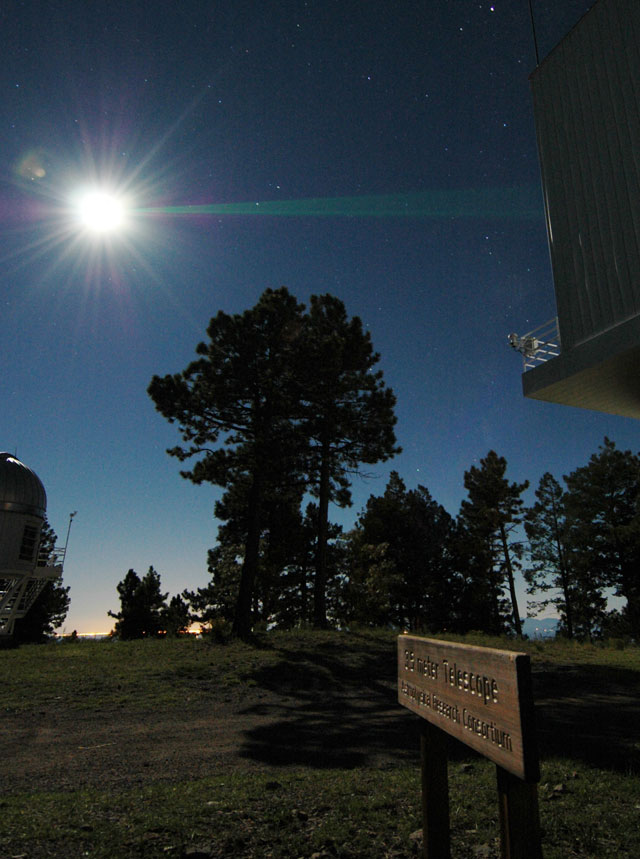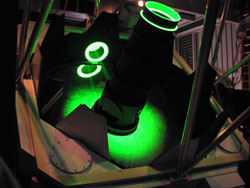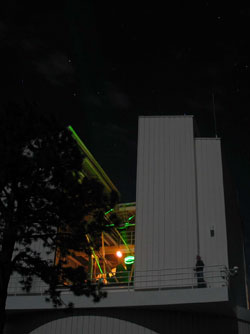
We might have to alter, dramatically, our assumptions about how the universe functions and our notions about its size and shape. We might have to come up with a whole new scientific vision of the history of the cosmos and how it evolved.
If this sounds akin to science fiction or theology, it isn’t. Scientists are working busily to determine if in fact gravity “misbehaves” in light of Einstein’s theory of general relativity. The Department of Physics and Astronomy at Humboldt State is part of the research, which is funded by NASA and the National Science Foundation.
The project is called APOLLO, not to be confused with the U.S. manned missions to the moon a half-century ago. Now APOLLO stands for Apache Point Observatory Lunar Laser-ranging Operation.
Apache Point is a 10,000 ft. peak in southern New Mexico with a good atmosphere for “seeing” into outer space. It is home to an ultra-sophisticated telescope with an 11-foot diameter mirror that scientists use to fire green laser pulses at the moon. Operations began in mid-2005.
APOLLO measures the round-trip travel time of the light pulse to within a fraction of a billionth of a second. That corresponds to about one millimeter of precision in the range to the moon, some 238,000 miles distant.
The laser beams bounce off suitcase-sized retro-reflector arrays placed on the lunar surface in the mid-20th century by Apollo astronauts and by two French-built, Soviet-launched unmanned landers. The laser data are analyzed and then transmitted to the Jet Propulsion Laboratory (JPL) in Pasadena for further scrutiny and interpretation. HSU physics professor C.D. Hoyle, together with project leader and professor Tom Murphy of UC San Diego and colleagues at JPL and other institutions hope to have an initial key finding in a year or two.
The idea is to gauge from the laser shots the relative acceleration of the earth and moon toward the sun and the shape of the moon’s orbit.
What does this have to do with gravity and the nature of the universe?

Here the plot thickens and Hoyle explains. As the Earth and the moon orbit the sun, they are in a perpetual state of falling toward it. This calculation stems from a basic precept of Einstein’s theory of gravity called the equivalence principle. In everyday life, the equivalence principle means that a rock and a feather dropped in a vacuum will accelerate equally in a gravitational field.
On that basis, Einstein’s theory predicts a very precise shape for the moon’s orbit as seen from Earth.
But if the shape of the moon’s orbit were to deviate from Einstein’s prediction, either his theory of relativity would be proved inexact or some other kind of force (or forces) might be acting on the two bodies, such that they do not accelerate at precisely the same rate.
The APOLLO laser shots at the moon, thousands of them and thousands more to come, are an attempt to measure possible deviations in the lunar orbit.
In Hoyle’s words, “The equivalence principle is fundamental to Einstein’s theory of general relativity, and if we detected a violation of it, it would throw off our understanding of how the universe works.”
Deviations in the lunar orbit would fuel notions about new, mysterious forces, such as “dark energy” in the cosmos. Dark energy might be a repulsive or negative gravitational force or it might be a property of empty space, which is not “nothing.” Einstein discovered that it is possible, in effect, for more space to come into existence. In theory, empty space can possess its own energy.
These ideas are highly theoretical explanations of the puzzling effect that seems to cause the universe to expand at an accelerating rate. That acceleration itself could inflect the shape of the lunar orbit.
Hoyle underlines that the moon’s orbit is not just a simple circle. It is subject to a host of gravitational forces other than the Earth’s, including those of all the other planets and asteroids in the solar system.
“To some extent,” he says, “our Apache Point laser ranging is a way to probe the curvature of space-time in the Earth-moon system, as well as measuring the equivalence principle. The fact that all objects exist in this curved space-time is the reason that they all fall the same way. So the equivalence principle and modeling gravity as a curvature of space-time are inextricably tied together in the theory of relativity. If we were to observe some breakdown of that, it would change profoundly how we view the universe.”

For example, dark energy, which appears to be a form of repulsive gravity on a gargantuan scale, may act over short distances and change the shapes of celestial orbits at extremely subtle levels.
“If that were true, we’d have to come up with some other explanation to describe gravity,” says Hoyle. “We could even be mistaken in our assumption that we live in four dimensions of space-time. Notional modifications of the moon’s orbit arise from string theories, which suggest the possibility of extra dimensions. If we were living in a five-six-seven-eight dimensional cosmological reality, that would imply a number of things—including the possibility there are multiple universes parallel to ours.”
The possibility of more than one universe is a popular notion these days in theoretical physics, despite the fact there is no evidence for it.
“But if you did determine there to be some modifications of the moon’s orbit, it could be due to multiple universes,” Hoyle says. “It could affect our estimates of the age of the universe. It might be somewhat younger, or older, than the currently projected 13.7 billion years. If gravity were shown to behave differently than we believe it does, it might radically change how we interpret the history and evolution of the universe. We’d have to come up with a new theory of gravity.”
Evidence of a breakdown in relativity is crucial to scientific understanding because it might be a clue to why Einstein’s theory and the concept of quantum mechanics do not agree mathematically. That divide is one of the biggest puzzles in contemporary physics and astrophysics. “Verifying a breakdown in relativity might be a clue to how to merge the two concepts, either via string theory or something else,” says Hoyle. The quantum theory of matter claims that “empty space” is in fact full of so-called “virtual” particles that form and disappear in a continuing cycle.
The collaborative work with JPL in Pasadena centers on how well the APOLLO data fit with Einstein's model. The study involves a lot of interplay between theory and experiment. It also requires making allowance for a host of influences on the measurements. Weather, tides, changes in the Earth’s crust, atmospheric effects, ground water fluctuations, the pressure of sunlight on the moon’s orbit (it throws the moon’s orbit slightly off center, by 3.65 millimeters), even continental drift must be compensated for in the laboratory.
“You have to wade through a lot of variables and that takes time,” says Hoyle. “The tide deflects the crust of the earth enough in New Mexico that it is measurable in our experiment. But possibly in a year or so we’ll have our first measurement of the equivalence principle. We need enough cycles of the moon to build confidence in your measurements and there are only about 12 of those a year.”